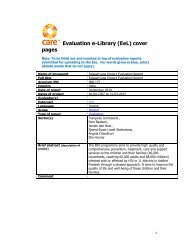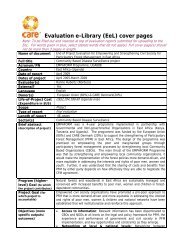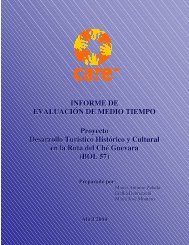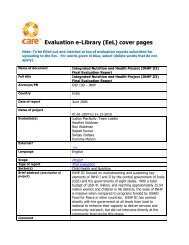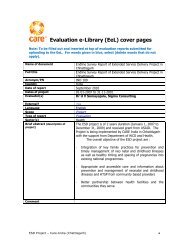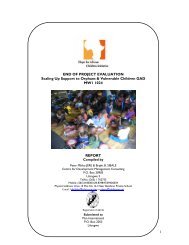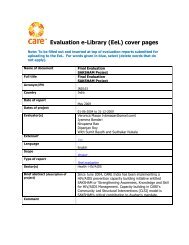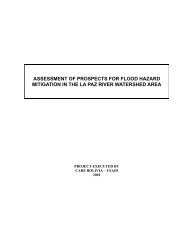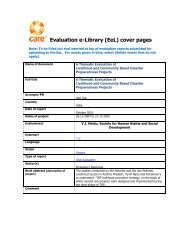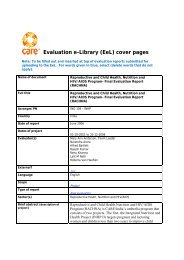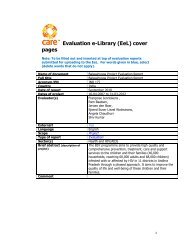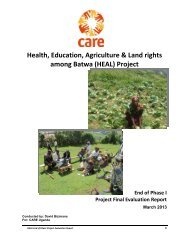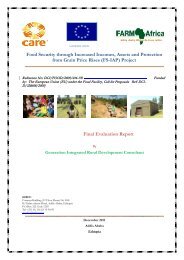IND 199 ECDE Baseline - CARE International's Electronic ...
IND 199 ECDE Baseline - CARE International's Electronic ...
IND 199 ECDE Baseline - CARE International's Electronic ...
- No tags were found...
Create successful ePaper yourself
Turn your PDF publications into a flip-book with our unique Google optimized e-Paper software.
xciiiTable 9.1: Distribution of AWCs on quality of available physical infrastructure andmean on each sub-component (Contd..)(Percentage)Q.No.Scoring on availability ofphysical infrastructureInterventionAWCsIntermediateAWCsControlAWCs(n=) 62 60 625. Safety level of buildingThree or more of the conditions(listed in the checklist) exist 40.3 51.7 27.4Two of the conditions exist 43.5 36.7 33.9None or one of the conditionsexists 16.1 11.7 38.7Mean score 0.757 0.601 1.1136. Noise pollutionMost of the time while observing,the sound from outside sourcesprevents hearing of conversationin the center.21 33.3 11.3For some of the time the soundfrom outside prevents hearing ofconversation.58.1 45 30.6There is no disturbance fromoutside source which preventshearing of conversation most ofthe time. 21 21.7 58.1Mean score 1.001 0.884 1.4687. Sitting facility for childrenChildren are sitting on a bare floorwith no covering.35.5 41.7 4.8Children are on a mat but it is tornor unclean or not enough for all.43.5 33.3 37.1Children are sitting on chairs or aclean mat. 21 25 58.1Mean score 0.855 0.833 1.533It may be noted that majority of the AWCs are at the poorest level of the infrastructure on allcomponents except the components of “noise pollution” and “sitting facility” where thesecond poorest levels is the largest. In the case of component of “cleanliness”, both thepoorest and second poorest levels are about equal in proportion. Infrastructure of the controlAWCs seems to be better than the intervention/intermediate AWCs.The scores of each component are also shown in the Table. Though the mean scores couldvary from 0 to 2 but the actual score on most of the items was less than 1—slightly better incontrol district that other two districts.94 9.2 Programme content of pre-school education (3-6 year children)As stated earlier, the programme content of the pre-school education has been divided intofive (children’s) development sub-components: (1) learning/play aids, programme scheduleand class arrangements, (2) personal care, hygiene and habit formation, (3) language andreasoning experience, (4) creative activities, and (5) social development. Within eachcomponent, there are a few activities whose level is being assessed and scored 0 to 2. Theanalysis of each of these sub-component has been shown in Tables 9.2 to 9.6.<strong>Baseline</strong> Study Of Early Childhood Care And Development Project In ChattisgarhApril,2012



